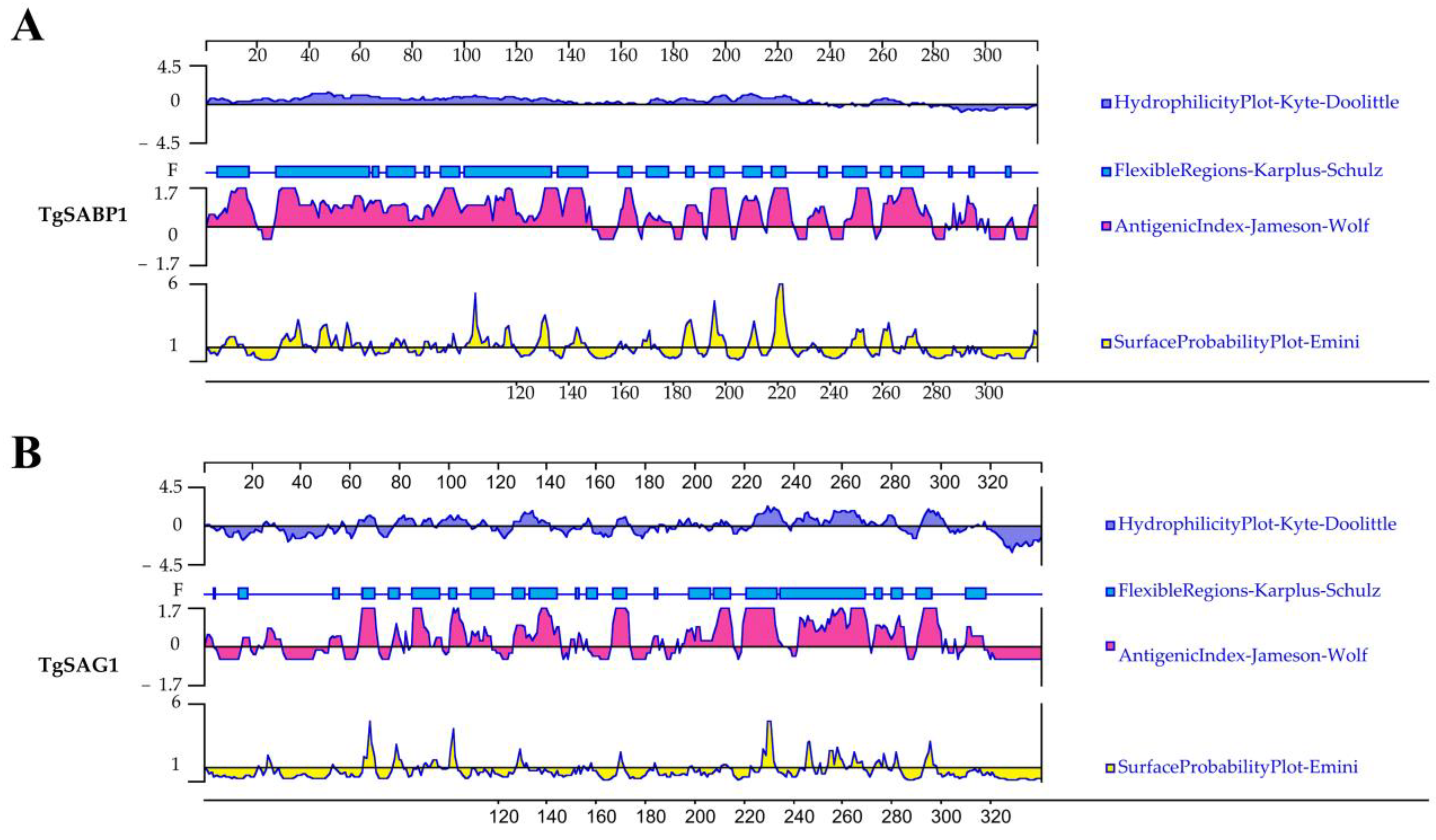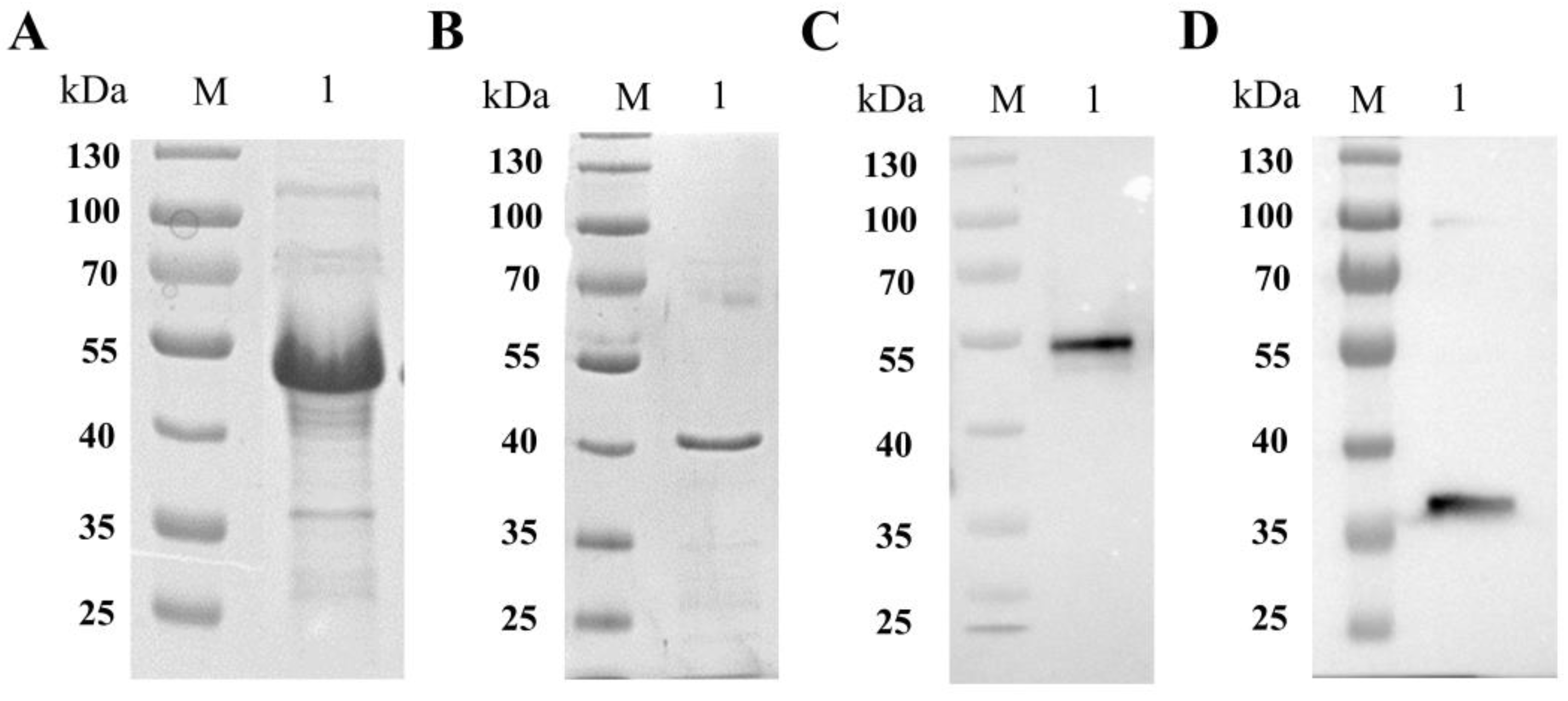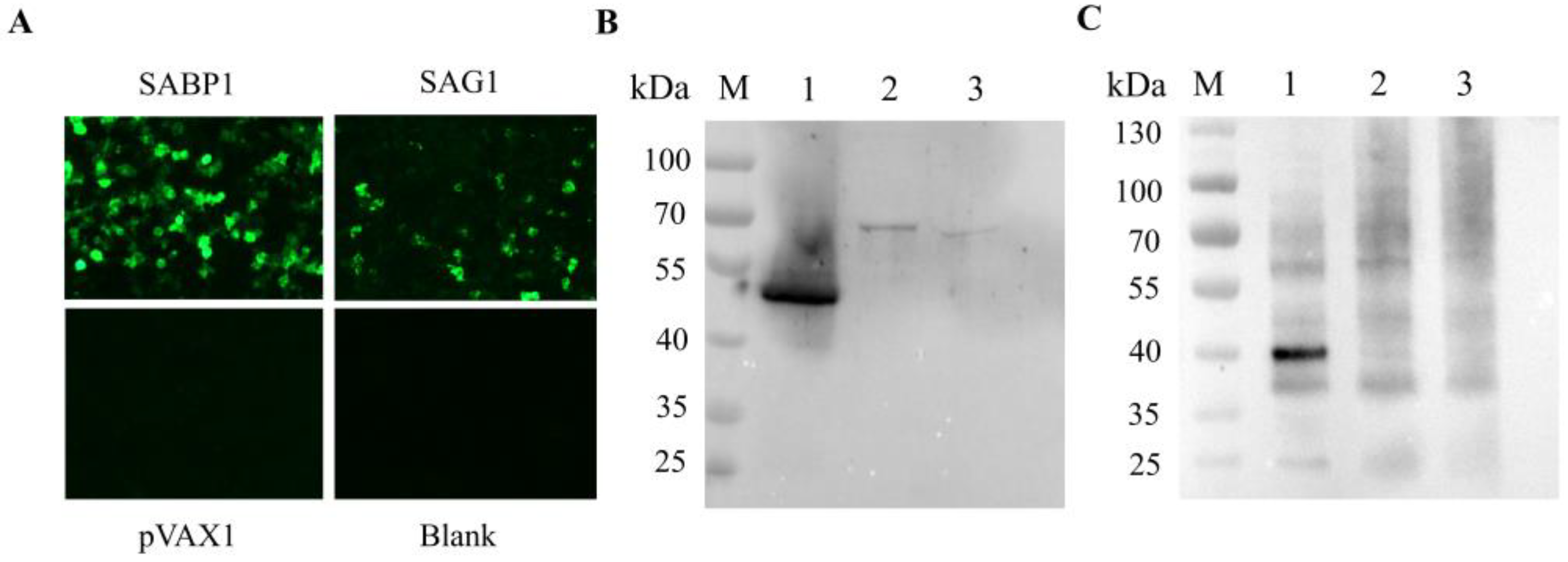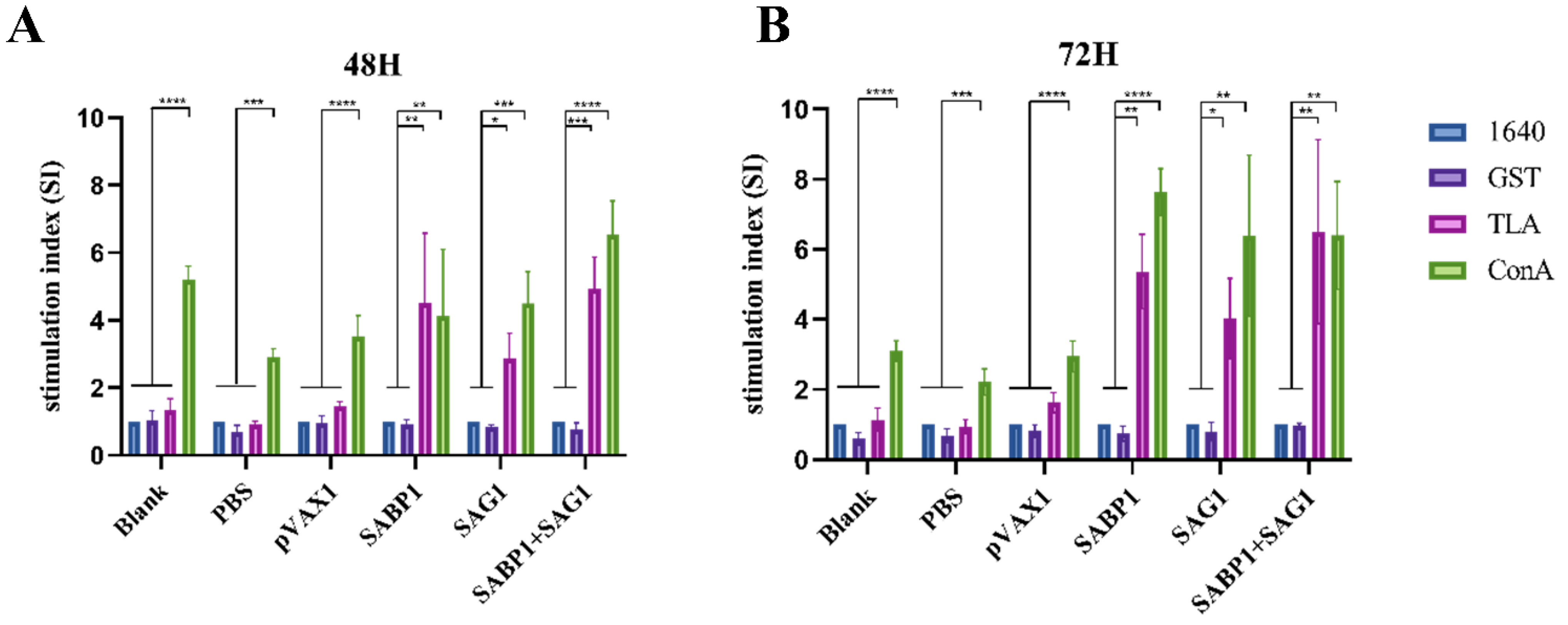Co-Immunization with DNA Vaccines Expressing SABP1 and SAG1 Proteins Effectively Enhanced Mice Resistance to Toxoplasma gondii Acute Infection
Abstract
:1. Introduction
2. Materials and Methods
2.1. Mice and Parasites
2.2. Polyclonal Antibody Preparation against Recombinant SABP1 and SAG1 Proteins Expressed by E. coil
2.3. Eukaryotic Expression Plasmid Construction
- pVAX1-SABP1-5: 5′ AACTTAAGCTTGCCACCATGGGATCTGGCAACAAC 3′,
- pVAX1-SABP1-3: 5′ TCCGTCTAGATCAATGGTGATGGTGATGATGCTTC 3′,
- pVAX1-SAG1-5: 5′ ACCCAAGCTTATGGGCAGCAGCCAT 3′,
- pVAX1-SAG1-3: 5′ CTAGTCTAGATCAGTGGTGGTGGGTGGGTGGGT 3′.
2.4. IFA and Western Blot Detection of pVAX1-SABP1 and pVAX1-SAG1 In Vitro
2.5. Mouse Immunization and T. gondii Challenge
2.6. Antibody Response Measurement
2.7. Spleen Lymphocyte Proliferation Test (CCK-8)
2.8. Cytokine Assays
2.9. Statistical Analysis
3. Results
3.1. Bioinformatic Analysis Identified B and T Cell Epitopes of the SABP1 and SAG1 Proteins
3.2. Preparation of Polyclonal Antibody of Recombinant SABP1 and SAG1 Proteins Expressed by E. coli
3.3. Expression of pVAX1-SABP1 and pVAX1–SAG1 in HEK293T Cells
3.4. Combined DNA Vaccines Induced Mice to Produce Higher Levels of IgG and Subtype IgG1, IgG2a Abs
3.5. Splenocyte Proliferation
3.6. Th1 Cytokines (IFN-γ, IL-12p70, IL-2) and Th2 Cytokines (IL-4) Significantly Increased Levels in Combined Immunized Mice
3.7. Combined DNA Vaccines Immunization Effectively Prolonged the Survival Time of T. gondii-Infected Mice
4. Discussion
5. Conclusions
Author Contributions
Funding
Institutional Review Board Statement
Informed Consent Statement
Data Availability Statement
Conflicts of Interest
References
- Hakimi, M.A.; Olias, P.; Sibley, L.D. Toxoplasma Effectors Targeting Host Signaling and Transcription. Clin. Microbiol. Rev. 2017, 30, 615–645. [Google Scholar] [CrossRef] [Green Version]
- Molan, A.; Nosaka, K.; Hunter, M.; Wang, W. Global status of Toxoplasma gondii infection: Systematic review and prevalence snapshots. Trop. Biomed. 2019, 36, 898–925. [Google Scholar] [PubMed]
- Wang, L.; Cheng, H.W.; Huang, K.Q.; Xu, Y.H.; Li, Y.N.; Du, J.; Yu, L.; Luo, Q.L.; Wei, W.; Jiang, L.; et al. Toxoplasma gondii prevalence in food animals and rodents in different regions of China: Isolation, genotyping and mouse pathogenicity. Parasites Vectors 2013, 6, 273. [Google Scholar] [CrossRef] [Green Version]
- Elsheikha, H.M.; Marra, C.M.; Zhu, X.Q. Epidemiology, Pathophysiology, Diagnosis, and Management of Cerebral Toxoplasmosis. Clin. Microbiol. Rev. 2021, 34, e00115-19. [Google Scholar] [CrossRef] [PubMed]
- Flegr, J.; Prandota, J.; Sovickova, M.; Israili, Z.H. Toxoplasmosis—A global threat. Correlation of latent toxoplasmosis with specific disease burden in a set of 88 countries. PLoS ONE 2014, 9, e90203. [Google Scholar] [CrossRef]
- Zhang, N.Z.; Chen, J.; Wang, M.; Petersen, E.; Zhu, X.Q. Vaccines against Toxoplasma gondii: New developments and perspectives. Expert Rev. Vaccines 2013, 12, 1287–1299. [Google Scholar] [CrossRef]
- Wang, J.L.; Zhang, N.Z.; Li, T.T.; He, J.J.; Elsheikha, H.M.; Zhu, X.Q. Advances in the Development of Anti-Toxoplasma gondii Vaccines: Challenges, Opportunities, and Perspectives. Trends Parasitol. 2019, 35, 239–253. [Google Scholar] [CrossRef] [PubMed]
- Jongert, E.; Roberts, C.W.; Gargano, N.; Forster-Waldl, E.; Petersen, E. Vaccines against Toxoplasma gondii: Challenges and opportunities. Memórias Inst. Oswaldo Cruz 2009, 104, 252–266. [Google Scholar] [CrossRef] [PubMed] [Green Version]
- Burrells, A.; Benavides, J.; Canton, G.; Garcia, J.L.; Bartley, P.M.; Nath, M.; Thomson, J.; Chianini, F.; Innes, E.A.; Katzer, F. Vaccination of pigs with the S48 strain of Toxoplasma gondii—Safer meat for human consumption. Vet. Res. 2015, 46, 47. [Google Scholar] [CrossRef] [Green Version]
- Chen, J.; Li, Z.Y.; Petersen, E.; Huang, S.Y.; Zhou, D.H.; Zhu, X.Q. DNA vaccination with genes encoding Toxoplasma gondii antigens ROP5 and GRA15 induces protective immunity against toxoplasmosis in Kunming mice. Expert Rev. Vaccines 2015, 14, 617–624. [Google Scholar] [CrossRef]
- Chen, J.; Zhou, D.H.; Li, Z.Y.; Petersen, E.; Huang, S.Y.; Song, H.Q.; Zhu, X.Q. Toxoplasma gondii: Protective immunity induced by rhoptry protein 9 (TgROP9) against acute toxoplasmosis. Exp. Parasitol. 2014, 139, 42–48. [Google Scholar] [CrossRef] [PubMed]
- Chu, J.Q.; Huang, S.; Ye, W.; Fan, X.Y.; Huang, R.; Ye, S.C.; Yu, C.Y.; Wu, W.Y.; Zhou, Y.; Zhou, W.; et al. Evaluation of Protective Immune Response Induced by a DNA Vaccine Encoding GRA8 against Acute Toxoplasmosis in a Murine Model. Korean J. Parasitol. 2018, 56, 325–334. [Google Scholar] [CrossRef] [PubMed] [Green Version]
- Tao, Q.; Fang, R.; Zhang, W.; Wang, Y.; Cheng, J.; Li, Y.; Fang, K.; Khan, M.K.; Hu, M.; Zhou, Y.; et al. Protective immunity induced by a DNA vaccine-encoding Toxoplasma gondii microneme protein 11 against acute toxoplasmosis in BALB/c mice. Parasitol. Res. 2013, 112, 2871–2877. [Google Scholar] [CrossRef] [PubMed]
- Xu, Y.; Zhang, N.Z.; Tan, Q.D.; Chen, J.; Lu, J.; Xu, Q.M.; Zhu, X.Q. Evaluation of immuno-efficacy of a novel DNA vaccine encoding Toxoplasma gondii rhoptry protein 38 (TgROP38) against chronic toxoplasmosis in a murine model. BMC Infect. Dis. 2014, 14, 525. [Google Scholar] [CrossRef] [Green Version]
- Zheng, B.; Lou, D.; Ding, J.; Zhuo, X.; Ding, H.; Kong, Q.; Lu, S. GRA24-Based DNA Vaccine Prolongs Survival in Mice Challenged with a Virulent Toxoplasma gondii Strain. Front. Immunol. 2019, 10, 418. [Google Scholar] [CrossRef] [Green Version]
- Zhu, W.N.; Wang, J.L.; Chen, K.; Yue, D.M.; Zhang, X.X.; Huang, S.Y.; Zhu, X.Q. Evaluation of protective immunity induced by DNA vaccination with genes encoding Toxoplasma gondii GRA17 and GRA23 against acute toxoplasmosis in mice. Exp. Parasitol. 2017, 179, 20–27. [Google Scholar] [CrossRef]
- Zhu, Y.; Xu, Y.; Hong, L.; Zhou, C.; Chen, J. Immunization with a DNA Vaccine Encoding the Toxoplasma gondii’s GRA39 Prolongs Survival and Reduce Brain Cyst Formation in a Murine Model. Front. Microbiol. 2021, 12, 630682. [Google Scholar] [CrossRef]
- Zhu, Y.C.; Ma, L.J.; Zhang, J.L.; Liu, J.F.; He, Y.; Feng, J.Y.; Chen, J. Protective Immunity Induced by TgMIC5 and TgMIC16 DNA Vaccines Against Toxoplasmosis. Front. Cell. Infect. Microbiol. 2021, 11, 686004. [Google Scholar] [CrossRef]
- Liu, M.A. DNA vaccines: An historical perspective and view to the future. Immunol. Rev. 2011, 239, 62–84. [Google Scholar] [CrossRef]
- Sepulveda, P.; Hontebeyrie, M.; Liegeard, P.; Mascilli, A.; Norris, K.A. DNA-Based immunization with Trypanosoma cruzi complement regulatory protein elicits complement lytic antibodies and confers protection against Trypanosoma cruzi infection. Infect. Immun. 2000, 68, 4986–4991. [Google Scholar] [CrossRef] [Green Version]
- Fang, R.; Feng, H.; Hu, M.; Khan, M.K.; Wang, L.; Zhou, Y.; Zhao, J. Evaluation of immune responses induced by SAG1 and MIC3 vaccine cocktails against Toxoplasma gondii. Vet. Parasitol. 2012, 187, 140–146. [Google Scholar] [CrossRef] [PubMed]
- Hoseinian Khosroshahi, K.; Ghaffarifar, F.; D’Souza, S.; Sharifi, Z.; Dalimi, A. Evaluation of the immune response induced by DNA vaccine cocktail expressing complete SAG1 and ROP2 genes against toxoplasmosis. Vaccine 2011, 29, 778–783. [Google Scholar] [CrossRef] [PubMed]
- Li, B.; Oledzka, G.; McFarlane, R.G.; Spellerberg, M.B.; Smith, S.M.; Gelder, F.B.; Kur, J.; Stankiewicz, M. Immunological response of sheep to injections of plasmids encoding Toxoplasma gondii SAG1 and ROP1 genes. Parasite Immunol. 2010, 32, 671–683. [Google Scholar] [CrossRef] [PubMed]
- Sobati, H.; Dalimi, A.; Kazemi, B.; Ghaffarifar, F. Evaluation of Anti-Toxoplasma gondii Immune Responses in BALB/c Mice Induced by DNA Vaccines Encoding Surface Antigen 1 (SAG1) and 3 (SAG3). Mol. Genet. Microbiol. Virol. 2019, 34, 59–66. [Google Scholar] [CrossRef]
- Sun, H.; Li, J.; Xiao, T.; Huang, X.D.; Wang, L.J.; Huang, B.C.; Yin, K.; Liu, G.Z.; Xu, C.; Wei, Q.K. Protective immunity induced by a DNA vaccine cocktail expressing TgSAG1, TgROP2, and the genetic adjuvant HBsAg against Toxoplasma gondii infection. Microb. Pathog. 2020, 147, 104441. [Google Scholar] [CrossRef]
- Wu, L.; Yang, H.; Wang, J.; Yu, X.; He, Y.; Chen, S. A Novel Combined DNA Vaccine Encoding Toxoplasma gondii SAG1 and ROP18 Provokes Protective Immunity Against a Lethal Challenge in Mice. Acta Parasitol. 2021, 66, 1387–1395. [Google Scholar] [CrossRef]
- Xing, M.; Yang, N.; Jiang, N.; Wang, D.; Chen, Q. A sialic acid-binding protein SABP1 facilitated host cell attachment and invasion by Toxoplasma gondii. J. Infect. Dis. 2020, 222, 126–135. [Google Scholar] [CrossRef]
- Ma, C.; Li, G.; Chen, W.; Jia, Z.; Yang, X.; Pan, X.; Ma, D. Eimeria tenella: IMP1 protein delivered by Lactococcus lactis induces immune responses against homologous challenge in chickens. Vet. Parasitol. 2020, 289, 109320. [Google Scholar] [CrossRef]
- Cui, X.; Lei, T.; Yang, D.; Hao, P.; Li, B.; Liu, Q. Toxoplasma gondii immune mapped protein-1 (TgIMP1) is a novel vaccine candidate against toxoplasmosis. Vaccine 2012, 30, 2282–2287. [Google Scholar] [CrossRef]
- Iván, P.-F.; Sungwon, K.; Virginia, M.-H.; Francesca, S.; Tomley, F.M.; Blake, D.P. Vaccination with transgenic Eimeria tenella expressing Eimeria maxima AMA1 and IMP1 confers partial protection against high-level E. maxima challenge in a broiler model of coccidiosis. Parasites Vectors 2021, 13, 343. [Google Scholar]
- Jia, Y.; Benjamin, S.; Liu, Q.; Xu, Y.; Soldati-Favre, D. Toxoplasma gondii immune mapped protein 1 is anchored to the inner leaflet of the plasma membrane and adopts a novel protein fold. Biochim. Biophys. Acta 2017, 1865, 208–219. [Google Scholar] [CrossRef] [PubMed] [Green Version]
- Li, Y.; Zhou, H. Moving towards improved vaccines for Toxoplasma gondii. Expert. Opin. Biol. Ther. 2018, 18, 273–280. [Google Scholar] [CrossRef] [PubMed]
- Yin, G.; Lin, Q.; Qiu, J.; Qin, M.; Tang, X.; Suo, X.; Huang, Z.; Liu, X. Immunogenicity and protective efficacy of an Eimeria vaccine candidate based on Eimeria tenella immune mapped protein 1 and chicken CD40 ligand. Vet. Parasitol. 2015, 210, 19–24. [Google Scholar] [CrossRef] [PubMed]
- Yin, G.; Lin, Q.; Wei, W.; Qin, M.; Huang, Z. Protective immunity against Eimeria tenella infection in chickens induced by immunization with a recombinant C-terminal derivative of EtIMP1. Vet. Immunol. Immunopathol. 2014, 162, 117–121. [Google Scholar] [CrossRef]
- Yin, G.; Qin, M.; Liu, X.; Suo, J.; Wu, W. An Eimeria vaccine candidate based on Eimeria tenella immune mapped protein 1 and the TLR-5 agonist Salmonella typhimurium FliC flagellin. Biochem. Biophys. Res. Commun. 2013, 440, 437–442. [Google Scholar] [CrossRef]
- Sun, X.; Mei, M.; Zhang, X.; Han, F.; Jia, B.; Wei, X.; Chang, Z.; Lu, H.; Yin, J.; Chen, Q.; et al. The extracellular matrix protein mindin as a novel adjuvant elicits stronger immune responses for rBAG1, rSRS4 and rSRS9 antigens of Toxoplasma gondii in BALB/c mice. BMC Infect. Dis. 2014, 14, 429. [Google Scholar] [CrossRef] [Green Version]
- Robert-Gangneux, F.; Darde, M.L. Epidemiology of and diagnostic strategies for toxoplasmosis. Clin. Microbiol. Rev. 2012, 25, 264–296. [Google Scholar] [CrossRef] [Green Version]
- Sayles, P.C.; Gibson, G.W.; Johnson, L.L. B cells are essential for vaccination-induced resistance to virulent Toxoplasma gondii. Infect. Immun. 2000, 68, 1026–1033. [Google Scholar] [CrossRef] [Green Version]
- Hunter, C.A.; Sibley, L.D. Modulation of innate immunity by Toxoplasma gondii virulence effectors. Nat. Rev. Microbiol. 2012, 10, 766–778. [Google Scholar] [CrossRef] [Green Version]
- Pifer, R.; Yarovinsky, F. Innate responses to Toxoplasma gondii in mice and humans. Trends Parasitol. 2011, 27, 388–393. [Google Scholar] [CrossRef] [Green Version]
- Gigley, J.P.; Fox, B.A.; Bzik, D.J. Cell-mediated immunity to Toxoplasma gondii develops primarily by local Th1 host immune responses in the absence of parasite replication. J. Immunol. 2009, 182, 1069–1078. [Google Scholar] [CrossRef]
- Zheng, B.; Ding, J.; Chen, X.; Yu, H.; Lou, D.; Tong, Q.; Kong, Q.; Lu, S. Immuno-Efficacy of a T. gondii Secreted Protein with an Altered Thrombospondin Repeat (TgSPATR) As a Novel DNA Vaccine Candidate against Acute Toxoplasmosis in BALB/c Mice. Front. Microbiol. 2017, 8, 216. [Google Scholar] [CrossRef] [Green Version]
- Zhou, J.; Wang, L. SAG4 DNA and Peptide Vaccination Provides Partial Protection against T. gondii Infection in BALB/c Mice. Front. Microbiol. 2017, 8, 1733. [Google Scholar] [CrossRef] [PubMed] [Green Version]
- Silva, N.M.; Vieira, J.C.; Carneiro, C.M.; Tafuri, W.L. Toxoplasma gondii: The role of IFN-gamma, TNFRp55 and iNOS in inflammatory changes during infection. Exp. Parasitol. 2009, 123, 65–72. [Google Scholar] [CrossRef] [PubMed]
- Dupont, C.D.; Christian, D.A.; Hunter, C.A. Immune response and immunopathology during toxoplasmosis. Semin. Immunopathol. 2012, 34, 793–813. [Google Scholar] [CrossRef] [Green Version]
- Boehm, U.; Klamp, T.; Groot, M.; Howard, J.C. Cellular responses to interferon-gamma. Annu. Rev. Immunol. 1997, 15, 749–795. [Google Scholar] [CrossRef] [PubMed]
- Miller, C.M.; Boulter, N.R.; Ikin, R.J.; Smith, N.C. The immunobiology of the innate response to Toxoplasma gondii. Int. J. Parasitol. 2009, 39, 23–39. [Google Scholar] [CrossRef]
- Saeij, J.P.; Frickel, E.M. Exposing Toxoplasma gondii hiding inside the vacuole: A role for GBPs, autophagy and host cell death. Curr. Opin. Microbiol. 2017, 40, 72–80. [Google Scholar] [CrossRef]
- Wallace, G.R.; Stanford, M.R. Immunity and Toxoplasma retinochoroiditis. Clin. Exp. Immunol. 2008, 153, 309–315. [Google Scholar] [CrossRef]
- Matowicka-Karna, J.; Dymicka-Piekarska, V.; Kemona, H. Does Toxoplasma gondii infection affect the levels of IgE and cytokines (IL-5, IL-6, IL-10, IL-12, and TNF-alpha)? Clin. Dev. Immunol. 2009, 2009, 374696. [Google Scholar] [CrossRef] [Green Version]
- LaRosa, D.F.; Stumhofer, J.S.; Gelman, A.E.; Rahman, A.H.; Taylor, D.K.; Hunter, C.A.; Turka, L.A. T cell expression of MyD88 is required for resistance to Toxoplasma gondii. Proc. Natl. Acad. Sci. USA 2008, 105, 3855–3860. [Google Scholar] [CrossRef] [PubMed]







| MHC II Allele 1 | Start-Stop 2 | Percentile Rank 3 | ||
|---|---|---|---|---|
| SAG1 | SABP1 | SAG1 | SABP1 | |
| H2-IAb | 26–40 | 33–47 | 0.95 | 1.7 |
| H2-IAd | 20–34 | 20–34 | 2.75 | 9.55 |
| H2-IEd | 14–28 | 10–24 | 3.35 | 0.25 |
Disclaimer/Publisher’s Note: The statements, opinions and data contained in all publications are solely those of the individual author(s) and contributor(s) and not of MDPI and/or the editor(s). MDPI and/or the editor(s) disclaim responsibility for any injury to people or property resulting from any ideas, methods, instructions or products referred to in the content. |
© 2023 by the authors. Licensee MDPI, Basel, Switzerland. This article is an open access article distributed under the terms and conditions of the Creative Commons Attribution (CC BY) license (https://creativecommons.org/licenses/by/4.0/).
Share and Cite
Sang, X.; Li, X.; Chen, R.; Feng, Y.; He, T.; Zhang, X.; El-Ashram, S.; Al-Olayan, E.; Yang, N. Co-Immunization with DNA Vaccines Expressing SABP1 and SAG1 Proteins Effectively Enhanced Mice Resistance to Toxoplasma gondii Acute Infection. Vaccines 2023, 11, 1190. https://doi.org/10.3390/vaccines11071190
Sang X, Li X, Chen R, Feng Y, He T, Zhang X, El-Ashram S, Al-Olayan E, Yang N. Co-Immunization with DNA Vaccines Expressing SABP1 and SAG1 Proteins Effectively Enhanced Mice Resistance to Toxoplasma gondii Acute Infection. Vaccines. 2023; 11(7):1190. https://doi.org/10.3390/vaccines11071190
Chicago/Turabian StyleSang, Xiaoyu, Xiang Li, Ran Chen, Ying Feng, Ting He, Xiaohan Zhang, Saeed El-Ashram, Ebtsam Al-Olayan, and Na Yang. 2023. "Co-Immunization with DNA Vaccines Expressing SABP1 and SAG1 Proteins Effectively Enhanced Mice Resistance to Toxoplasma gondii Acute Infection" Vaccines 11, no. 7: 1190. https://doi.org/10.3390/vaccines11071190






